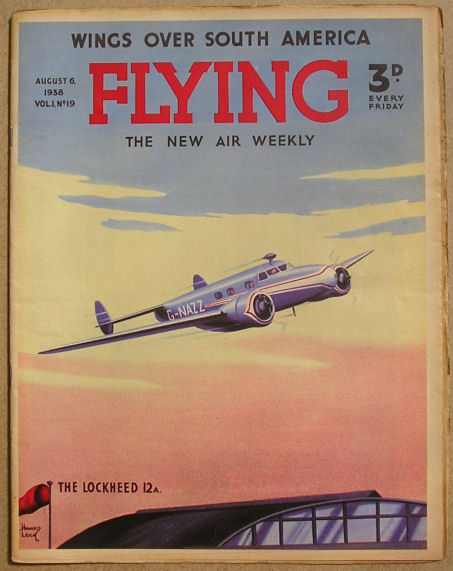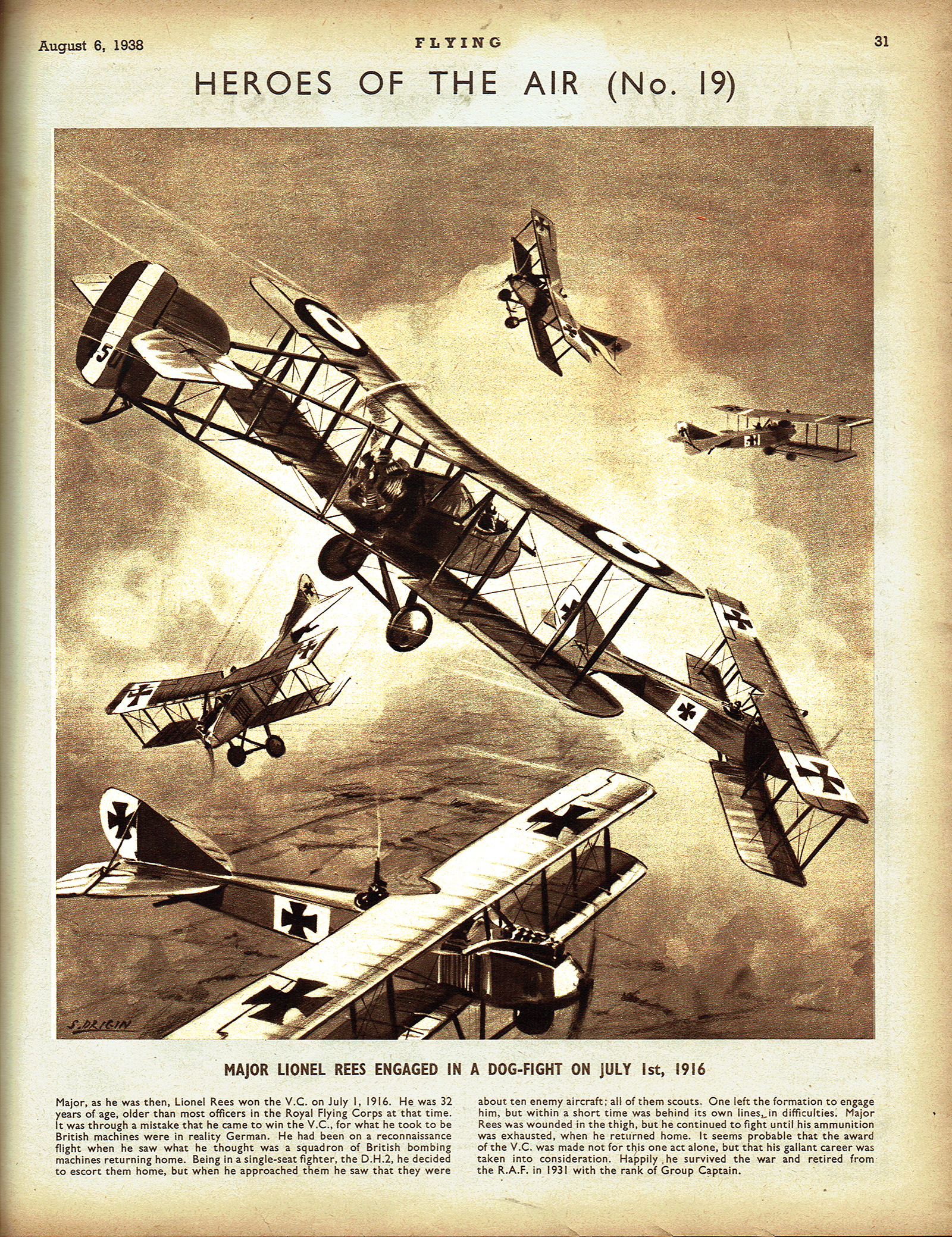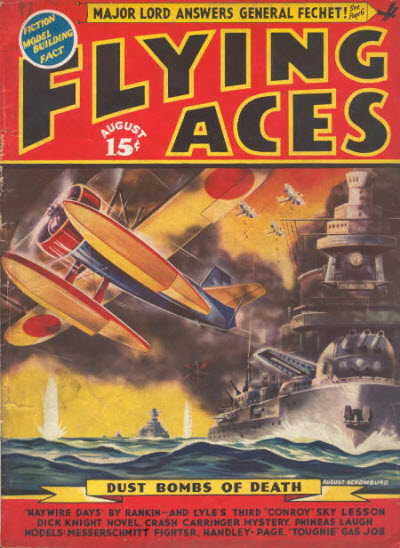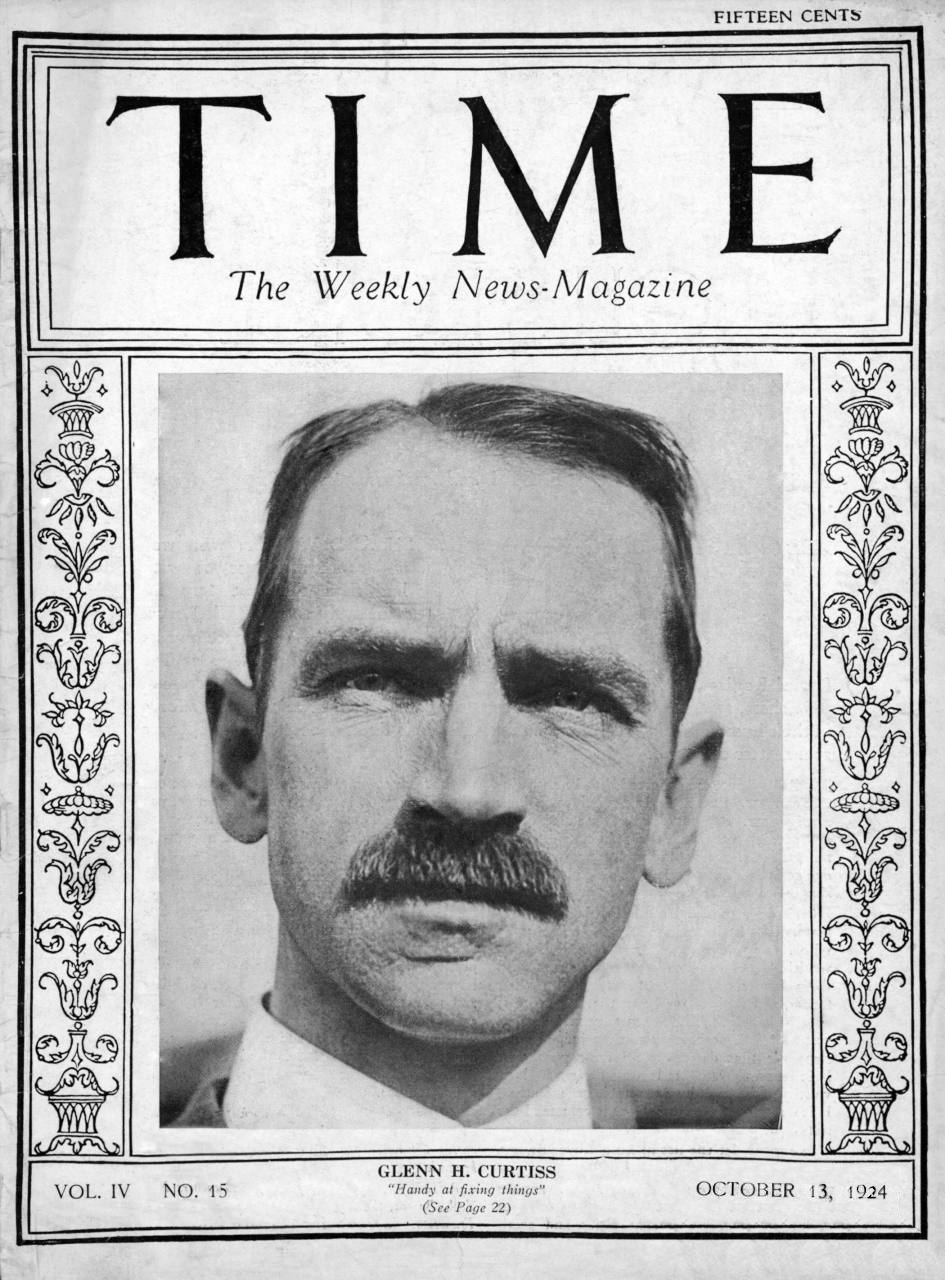Heroes of the Air: Major Lionel Rees
WHEN Flying, the new  weekly paper of all things aviation, started up in England in 1938, amongst the articles and stories and photo features was an illustrative feature called “Heroes of the Air.” It was a full page illustration by S. Drigin of the events surrounding how the pictured Ace got their Victoria Cross along with a brief explanatory note.
weekly paper of all things aviation, started up in England in 1938, amongst the articles and stories and photo features was an illustrative feature called “Heroes of the Air.” It was a full page illustration by S. Drigin of the events surrounding how the pictured Ace got their Victoria Cross along with a brief explanatory note.
Russian born Serge Drigin became a successful illustrator in the UK in the 1920s with his work regularly appearing in such British magazines as The Detective Magazine, Modern Boy and Chums. He is probably best known for his startling covers for Scoops, Air Stories, War Stories, Fantasy and others in the 30s.
From the 6 August 1938 issue of Flying:
MAJOR LIONEL REES ENGAGED IN A DOG-FIGHT ON JULY 1st, 1916
MAJOR, as he was then, Lionel Rees won the V.C. on July 1, 1916. He was 32 years of age, older than most officers in the Royal Flying Corps at that time. It was through a mistake that he came to win the V.C., for what he took to be British machines were in reality German. He had been on a reconnaissance flight when he saw what he thought was a squadron of British bombing machines returning home. Being in a single-seat fighter, the D.H.2, he decided to escort them home, but when he approached them he saw that they were about ten enemy aircraft; all of them scouts. One left the formation to engage him, but within a short time was behind its own lines in difficulties. Major Rees was wounded in the thigh, but he continued to fight until his ammunition was exhausted, when he returned home. It seems probable that the award of the V.C. was made not for this one act alone, but that his gallant career was taken into consideration. Happily, he survived the war and retired from the R.A.F. in 1931 with the rank of Group Captain.

“Tripe of Peace” by Joe Archibald
“HAW-W-W-W-W!† That sound can only mean one thing—that Bachelor of Artifice, Knight of Calamity and an alumnus of Doctor Merlin’s Camelot College for Conjurors is back to vex not only the Germans, but the Americans—the Ninth Pursuit Squadron in particular—as well. Yes it’s the marvel from Boonetown, Iowa himself—Lieutenant Phineas Pinkham!
That sound can only mean one thing—that Bachelor of Artifice, Knight of Calamity and an alumnus of Doctor Merlin’s Camelot College for Conjurors is back to vex not only the Germans, but the Americans—the Ninth Pursuit Squadron in particular—as well. Yes it’s the marvel from Boonetown, Iowa himself—Lieutenant Phineas Pinkham!
The Germans have developed a new, sinister gas bomb that makes a person have no desire to fight and love their fellow man. What kind of war would that be? Needless to say, the Boomtown marvel sets out to find the source of this new deadly destruction and in the process inspires a put-upon German corporal named Adolph to dream big—real big!
When the Kraut concoction cooker-uppers caused a flock of Allied flyers to forsake their battle buggies in favor of a Western Front version of the Yassar daisy chain, Rufus Garrity roared, “It’s impossible!†Of course, when his own sky-scrappers got messed up with Kid Maxie, the Munich Mauler, the fiery Major’s opinion had to be revised. All of which was a mere trifle. For after Phineas deftly tossed his Uncle Thaddeus’s Sioux shillelah, Heinie-land’s whole history had to be revised—believe it, or else!
“They Had What It Takes – Part 19: Glenn H. Curtiss†by Alden McWilliams
Flying Aces ran Alden McWilliams’ illustrated  tributes to the pioneer fliers of the early days of aviation from 1937 through 1940. This time McWilliams chronicles the life of Glenn H. Curtiss—the ace of plane makers! Like the Wright Brothers, Curtiss started out in bicycles, but went through motorcycles on his path to building planes. He is perhaps best known for the “Jenny” which the army used as a training plane during WWI. Curtiss was also a pioneer in sea plane development—here Curtiss tests a seaplane glider.
tributes to the pioneer fliers of the early days of aviation from 1937 through 1940. This time McWilliams chronicles the life of Glenn H. Curtiss—the ace of plane makers! Like the Wright Brothers, Curtiss started out in bicycles, but went through motorcycles on his path to building planes. He is perhaps best known for the “Jenny” which the army used as a training plane during WWI. Curtiss was also a pioneer in sea plane development—here Curtiss tests a seaplane glider.
“Hellion Hunch” by Arch Whitehouse
“Shut up and get a shovel!†Such was the impudent retort that Crash Carringer flung at old F.S.F. Winters, C.O. of No. 609, Britain’s brave little air post in the wilds of India’s Afridi-ridden North West Frontier. And that retort tartly expressed the nervy nature of the hard-shooting Yank warplane salesman. For Crash was tough. He needed all his toughness, too. For he was roaring’ off to a “date with Death†in the nullahs to prove that blood is thicker than— tobacco!
 weekly paper of all things aviation, started up in England in 1938, amongst the articles and stories and photo features was an illustrative feature called “Heroes of the Air.” It was a full page illustration by S. Drigin of the events surrounding how the pictured Ace got their Victoria Cross along with a brief explanatory note.
weekly paper of all things aviation, started up in England in 1938, amongst the articles and stories and photo features was an illustrative feature called “Heroes of the Air.” It was a full page illustration by S. Drigin of the events surrounding how the pictured Ace got their Victoria Cross along with a brief explanatory note. 





 That sound can only mean one thing—that Bachelor of Artifice, Knight of Calamity and an alumnus of Doctor Merlin’s Camelot College for Conjurors is back to vex not only the Germans, but the Americans—the Ninth Pursuit Squadron in particular—as well. Yes it’s the marvel from Boonetown, Iowa himself—Lieutenant Phineas Pinkham!
That sound can only mean one thing—that Bachelor of Artifice, Knight of Calamity and an alumnus of Doctor Merlin’s Camelot College for Conjurors is back to vex not only the Germans, but the Americans—the Ninth Pursuit Squadron in particular—as well. Yes it’s the marvel from Boonetown, Iowa himself—Lieutenant Phineas Pinkham!  tributes to the pioneer fliers of the early days of aviation from 1937 through 1940. This time McWilliams chronicles the life of
tributes to the pioneer fliers of the early days of aviation from 1937 through 1940. This time McWilliams chronicles the life of